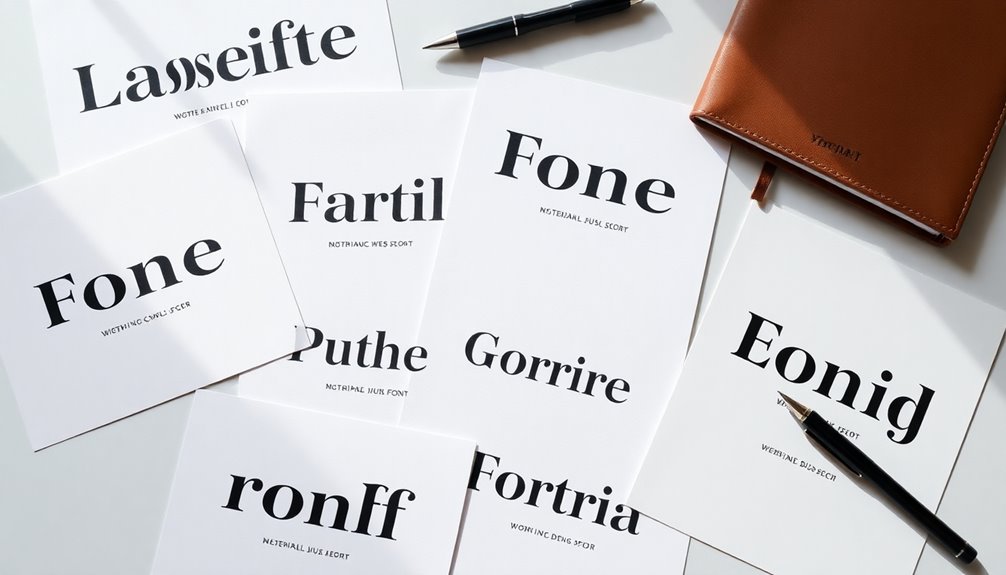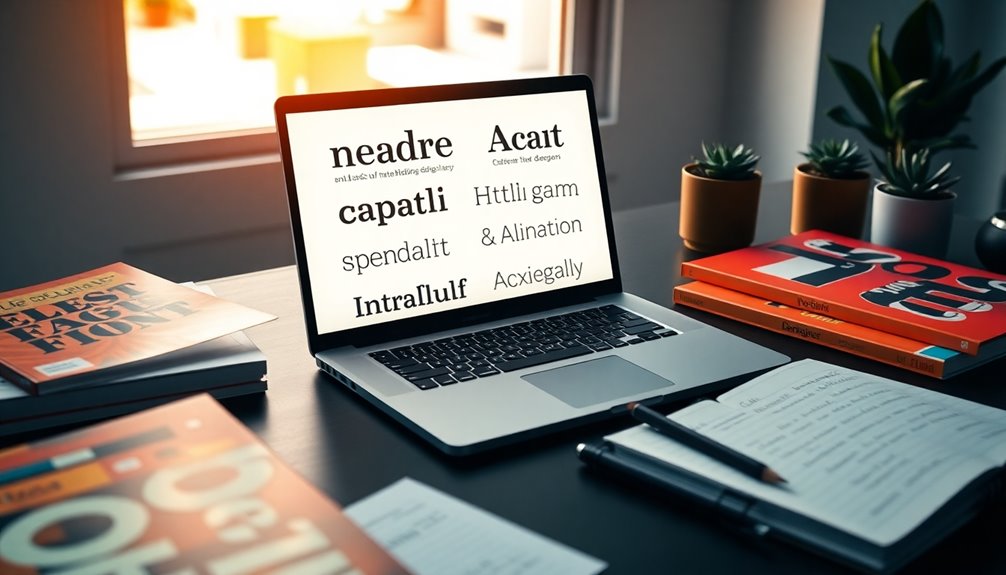Choosing the best fonts for your website is essential for standing out. Start by understanding the types of fonts—serif for tradition, sans serif for modernity, and script for elegance. Limit yourself to three fonts for a clean look and pair them wisely, using a primary font for headings and a secondary for body text. Always prioritize readability; aim for clear fonts and strong color contrasts. Keep up with typography trends to capture attention. When you make these thoughtful choices, you enhance the user experience and brand identity, making your site memorable. Discover more tips to elevate your typography strategy.
Importance of Typography
Typography plays an essential role in shaping how users perceive your website. It's not just about selecting pretty fonts; it's about enhancing your brand voice and identity. When you use consistent typography, you build trust and credibility with your visitors, reflecting your attention to detail and design coherence. Choosing the right typeface, like Roboto or Poppins, can significantly enhance your site's professional appearance. Additionally, establishing a well-planned backup strategy can protect your site's integrity.
Your choice of fonts greatly impacts readability. Well-selected typefaces improve user experience and keep users engaged with your content. If users struggle to read your text, they're likely to leave your site, which diminishes their overall experience. Regular backups can prevent significant downtime, ensuring your content remains accessible.
Typography also guides users through your website design, helping them navigate content effortlessly. Different font styles can evoke specific emotions and associations related to your brand, influencing how users feel as they interact with your site.
Ultimately, effective typography isn't just an aesthetic choice; it's a strategic decision that shapes user perception and enhances their journey on your website. Additionally, using lightweight themes like Astra can further improve load times, reinforcing the importance of a cohesive design approach.
Types of Website Fonts
When choosing the right font for your website, understanding the different types available is essential. There are three main categories: serif fonts, sans serif fonts, and script fonts. Each serves distinct purposes in typography design.
Serif fonts, with their small lines at the ends of letters, evoke tradition and elegance, making them perfect for formal web designs. Additionally, many websites benefit from SEO optimization as typography plays a role in enhancing user experience and readability. In fact, content quality can significantly impact how users perceive and engage with a site, which is crucial for maintaining interest. On the other hand, sans serif fonts provide a clean and modern appearance. They're highly legible, especially on digital screens, which is why they're often favored in web design.
Script fonts add a personal touch by mimicking handwritten styles but should be used sparingly. They're best suited for display text, like titles or headers, rather than body text due to potential readability issues. Customizing typography can greatly enhance the overall design of your website, as seen with themes like Astra(https://wpastra.com) that offer extensive font options.
Understanding these font types helps you align your typography choices with your website's overall tone and purpose. Whether you're aiming for a classic feel with serif fonts or a contemporary vibe with sans serif fonts, knowing the strengths of each type makes choosing fonts easier.
Font Pairing Techniques

Choosing the right font is just the beginning; knowing how to pair them effectively can elevate your website's design. Start by limiting your font choices to three types to maintain a cohesive look. Establish a primary font for headings that stands out, and a secondary font for body text that prioritizes readable text. An accent font can be used for special elements, like calls-to-action.
When applying font pairing techniques, experiment with contrasting styles. For example, pair a bold serif font with a clean sans serif to create visual interest. Make sure that your chosen fonts complement each other regarding size, weight, and style. This balance creates a harmonious visual hierarchy that guides your audience's attention effectively. Additionally, consider using a theme with SEO-friendly features to enhance overall website performance and visibility. Incorporating user feedback widgets can also help you understand how your audience interacts with your typography.
Before finalizing your choices, test font combinations using sample text. This allows you to evaluate compatibility and adjust as needed. Incorporating elegant typography in your design can significantly enhance the overall aesthetic and user engagement.
Ensuring Readability
Many web designers overlook the importance of readability, but it plays a vital role in user experience. To enhance comprehension and retention, you need to prioritize legibility in your typography choices.
Start with selecting readable fonts; sans serif fonts are often the best option for body text, especially in smaller sizes. Their clean lines improve legibility on digital screens, making your content more accessible.
When it comes to font size, aim for a range between 16pt to 18pt for body text. This size guarantees clarity and helps prevent eye strain during long passages.
Additionally, pay attention to contrast; a strong difference between the font color and background can greatly enhance legibility, making your content easier to read for all users.
Avoid decorative fonts in body text, as they can confuse readers and hinder user engagement. Such fonts often become challenging to read, particularly in lengthy sections of text. Regular backups should reflect the importance of your content, ensuring that valuable information remains accessible and protected.
Trends in Typography

Current trends in typography are shaping how we design websites, with a noticeable shift towards minimalism and bold aesthetics.
You'll find that clean, sans serif fonts are becoming the go-to choice for enhancing readability while conveying a modern feel. Bold typography is also on the rise, with oversized typefaces used to create impactful headlines that grab attention and emphasize key messages.
While serif fonts still have their place, many brands are opting for custom fonts to stand out. These unique typefaces reflect a company's identity and values, allowing for a more personalized touch in branding.
However, if you're considering handwritten or script fonts, use them sparingly to guarantee legibility; they're great for adding flair but can detract from overall clarity when overused.
Additionally, variable fonts are gaining traction. They allow for multiple styles and weights within a single file, simplifying font management and improving website performance.
Conclusion
In the end, choosing the right fonts isn't just about looks—it's about creating an experience. Imagine your visitors gliding effortlessly through your site, captivated by your content because it's easy to read and visually appealing. By understanding typography's importance, experimenting with font types and pairings, and prioritizing readability, you can truly elevate your website. So why settle for ordinary when you can make your text sing? Your choice of typography can turn heads and keep them turning!



